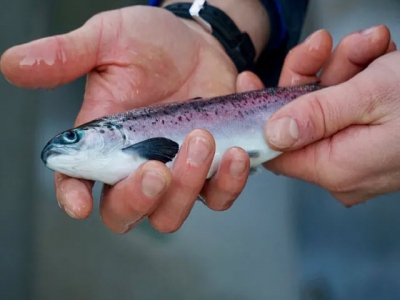RAS allows SSF to double smolt size

The first smolts to have been produced at Scottish Sea Farms’ new £55 million Barcaldine hatchery have been transferred to sea this week.
The first batch of smolts were transferred to sea at an average weight of 160 grams. Photo SSF
The smolts, which arrived at Barcaldine as eggs in January and were hatched and reared using a recirculating aquaculture system (RAS), had an average weight of 160 grams – more than double that of smolts grown by the company when using traditional hatchery methods.
Scottish Sea Farms’ freshwater manager, Pål Tangvik, said: “This is a major milestone for all of the team, not just at Barcaldine but across the company. The new hatchery has given us greater control over key factors including water quality, oxygen levels, temperature, light and speed of flow, meaning we have been able to ensure the best growing environment for the salmon. The result is bigger, more robust smolts that will be better able to withstand the natural challenges of the marine environment.
“We will also be able to shorten the time these salmon will spend at sea by up to two months which will reduce their exposure to these challenges and increase survival rates, and have longer fallow periods between crops which will contribute towards a safer environment for subsequent generations of fish.”
The young salmon were transferred directly from the Loch Creran-side hatchery onto a wellboat and then to one of Scottish Sea Farms’ Shetland farms, removing the need for transportation by road or air – another huge step forward in terms of fish welfare.
The new facility promises to be every bit as transformational with regards to environmental performance.
Operations manager for the hatchery, Noelia Rodriguez, explained: “Incoming water is filtered to remove any particles then disinfected using UV light and circulated to anywhere in the hatchery, where it is maintained at a constant temperature of between 12-14 degrees, before being cleaned again and recirculated every 20-30 minutes. Combined, this uses 98 percent less freshwater and significantly less energy compared with heating and cooling water at traditional hatcheries.
“Adding to this, the building uses a biomass energy system – thought to deliver the biggest CO2 savings of any renewable heat source – to provide heating and hot water, and there is provision for a hydro scheme so that we can generate even more energy in a greener way.”
The state-of-the-art facility, which includes four incubation units and four hatcheries, has taken over two years to build and is due to have its official opening in 2020.
Có thể bạn quan tâm
 Researchers examine antimicrobial resistance potential in aquaculture
Researchers examine antimicrobial resistance potential in aquaculture International team finds different mechanisms by which antimicrobial-resistant genes could spread among gut bacteria
 Seaweed supplementation shows delayed mortality in farmed seabass
Seaweed supplementation shows delayed mortality in farmed seabass A recent study suggests that supplementing farmed European seabass diets with Gracilaria sp. aqueous extract (GRA) can protect the fish from disease challenges
 New study shows vertical transmission of tilapia lake virus
New study shows vertical transmission of tilapia lake virus A recent study suggests that tilapia lake virus (TiLV) causes systemic infections that can move to the hosts’ reproductive organs and transmit the infection